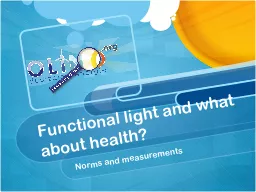

health Norms and measurements Healthy light DIN SPEC 67600201304 Biologically effective illumination design guidelines DIN SPEC 5031100201508 Measurement using the eye of the melanopic ID: 540756
Download Presentation The PPT/PDF document "Functional light and what about" is the property of its rightful owner. Permission is granted to download and print the materials on this web site for personal, non-commercial use only, and to display it on your personal computer provided you do not modify the materials and that you retain all copyright notices contained in the materials. By downloading content from our website, you accept the terms of this agreement.
Slide1
Functional light and what about health?
Norms and measurementsSlide2
Healthy light
DIN SPEC 67600:2013-04Biologically effective illumination, design guidelines
DIN SPEC 5031-100:2015-08
Measurement using the eye, of the
melanopic
effect of light on humans: variables, formula symbols and
actionspectrumSlide3
Biologically effective light can be healthy
The following positive effects
Stabilization of
human circadian system
Synchr
.
sleep-wake
with 24 hour
day-night
Re-
inforcement
of amplitude of
biol.
c
lock
Activation and improvement of
concentration
Facilitation and fostering of
regeneration
Improvement
moods
Strengthening
immune system
Note: to be applied to right time of the day!Slide4
Human circadian system
Biological rhythm of about 1 day length, variations inbody temperature
hormone
descretion
r
hythm of heart
a
ctivity and rest
Light can affect it and reset the timing of itSlide5
DIN SPEC 67600:2013-04
Observations but not further considered hereLight enters human not only via eyes (skin, hair roots)
Production of
Vit
-D done by UV-B
Focus in norm on
Non-visual effects of light transmitted through the eyes
Design guidelines fo
r living spaces (extended stay)
Statement: bio. effective light is not related to energy efficiency of visual
light
keep separate
Statement: better to use
melanopic
effects since normal vision is not considere
d (in biologic effects normal vision is included).Slide6
Melanopic effectiveness
Minimum 250 lux as vertical illuminance on the eye
At
Tc
= 8000 K (at eye) of a fluorescent TL
Beware of reflections and filtering!
Several hours of exposure a day
Preferably in the morning
Solid angle of light source is important
< 0.1
sr
no effect (20
deg
view angle)
> 0.1
sr
and < 0.5
sr
effect increases
> 0.5
sr
good effect (46
deg
view angle)
Coming from above or upper part of visual fieldSlide7
Office space
200lx_vert@3000K
Dependent on visual task (EN 12464-1) (also
lx_horiz
)
250lx_vert@8000KSlide8
Classroom i
200lx_vert@3000K
Dependent on visual task (EN 12464-1). See example for school day.Slide9
Class-room ii
650lx_horiz@12000K (
synchr
biol.
c
lock)
300lx_horiz@4000K (normal lesson)
1000lx_horiz@6000K (test/concentration work)
300lx@2700K (calming after test)
650lx@12000K (activate after lunch)Slide10
DIN SPEC 5031 -100:2015-08
a_mel_v
=
melanopic
factor for visual radiation
A: Determine
melanopic
effect of light with spectrum
X_λ
B: Determine visual effect of light with
spectrum
X_λ
Divide A/B to get
a_mel_v
s_mel
(
λ
)Slide11
Example
a_mel_vSlide12
Example
a_mel_vSlide13
a_mel_v in practice
Reference values:
From 67600: 250
lux_vert
for 8000K fluorescent TL
a
_mel_v
= 0.867
From 67600: 200
lux_vert
for 3000K light
a_mel_v
= 0.387
Given any lamp, once spectrum is determined we calculate the
a_mel_v
Compare to
a_mel_v
of 8000K
Tl
for which a recommendation exists, determine relation
Then change 250lx_vert into lux for any lamp using relationSlide14
a
_mel_v
in practice ii
a_mel_v_NOTEii
/a_mel_v_8000KTL= 1.015/0.867=1.17
So needed 250/1.17= 214
lux_vert
simulate
Dialux
!Slide15
Pupil and transmission effects
Correction factor based on Age:
k_mel
(A)
k_mel
(A)=
k_mel,trans
(A)*
k_mel,pupil
(A)
Trans = transmission through eye medium
Pupil = pupil size
a_mel_v
(A)=
a_mel_v
(32)*
k_mel
(A)
k_trans
values for 8000K TL: 1.055 (25yr), 1.000 (32yr), 0.825 (50yr), 0.569 (75yr), 0.437 (90yr)Slide16
Spectral transmission effectSlide17
Pupil effectSlide18
OliNo at LED-EXPO
Take your lamp and we measureFlicker content
Colo
r spectrum with CRI and CQS
Blue Light Hazard
For more explanations
For lamp measurement info